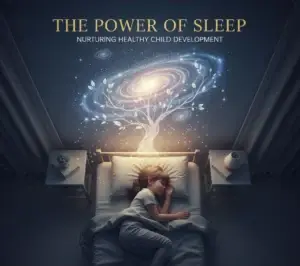A Neuroscientific-Psychological Analysis of Attachment and Child Development
۱. Introduction: The Silence That Speaks Louder Than a Thousand Words
۱.۱. The Communication Paradox and the Research Thesis (Hook)
In modern cultures, we often seek the power of communication in explicit words and verbal logic. However, in the most critical and delicate human relationship—the Parent-Child Dyad—neuroscience and behavioral psychology research fundamentally challenge this belief. In key moments of emotional regulation, trust-building, and safety transmission, it is the silence of the body and the unspoken tone of the parents that exert the most significant influence. How can an unconscious frown or a closed body posture hold more power than a thousand reassuring words?
This article aims to radically shift the perspective on the importance of parental body language. It is designed to convince even the most skeptical critics with robust scientific and logical arguments. We will prove that Nonverbal Communication (NVC) is not a secondary factor, but a Primary and Vital Communication System that directly impacts the child’s Neural Architecture and long-term mental health foundation.
۱.۲. The Argumentative Framework
Our argument rests on three pivotal scientific pillars that explain the mechanisms of NVC’s influence:
- Evolutionary Priority and Emotional Incongruence: Why does the child’s brain prioritize NVC over verbal language? (Revisiting Mehrabian’s Rule).
- The Neurobiological Mechanism: How does parental body language chemically alter the child’s brain via the Mirror Neuron System (MNS)?
- The Dynamics of Attachment: The essential role of Interactional Synchrony in constructing the child’s psychological security.
۲. Evolutionary Priority: The Superiority of Nonverbal Signals in the Child’s Brain
۲.۱. Survival and Processing Speed
For young organisms, rapidly discerning danger or safety from parents is a survival priority. Processing visual and auditory information (like facial expressions, tone of voice) in the visual and auditory cortices occurs significantly faster than the semantic and logical processing of speech in the Prefrontal Cortex. Consequently, the child’s brain, whose logical cortex is still immature, assigns a higher level of credibility to nonverbal signals.
۲.۲. The Precise Re-reading of Mehrabian’s Rule: The Power of Emotional Incongruence
The classic theory of Albert Mehrabian (1967) suggested that in communicating feelings, only 7% of the message is conveyed by words. However, the crucial point is that these ratios only apply when there is Emotional Incongruence between the verbal and nonverbal channels.
Scientific Argument: If a parent says, “No, I am not angry” (Verbal), but with a red face, tense muscles, and a strained tone (NVC), the child’s brain accepts the stronger signals (38% tone and 55% body language) as the Emotional Truth. This discrepancy severely reduces the child’s trust in the parent and leads to Cognitive Anxiety. Therefore, the importance of NVC lies not just in message transmission, but in validating the words.
۳. The Neurobiological Mechanism: Parental Body Language as a Regulator of the Child’s Brain Chemistry
The profound effect of parental NVC on the child’s nervous system is not an abstract process; it is a measurable neuro-chemical mechanism.
۳.۱. The Mirror Neuron System (MNS) and Emotional Contagion
The Mirror Neuron System (MNS), located primarily in the premotor and parietal cortices, is the biological foundation of empathy and understanding intentions.
- Empathy and Simulation: When a parent displays a calm face, a warm smile, and an open posture, the child’s MNS activates and simulates that same feeling of calmness in their own brain. This process is known as Emotional Contagion.
- Chemical Impact: Calming NVC triggers the release of Oxytocin (the attachment hormone) in the child’s brain, reinforcing the emotional bond and inducing a sense of security. Conversely, a parent’s frightened or angry facial expression activates the child’s Amygdala (the fear and danger center) and increases the secretion of Cortisol (the stress hormone). Chronic exposure to negative NVC can lead to Hyper-Vigilance of the nervous system in the long run.
۳.۲. Interactional Synchrony (IS) and Attachment
Interactional Synchrony (IS), documented by researchers such as Feldman, refers to the rhythmic, reciprocal, and precisely timed coordination in the micro-behaviors (nonverbal and verbal) between parent and infant/child. This “nonverbal dance” is more than simple imitation.
Scientific Argument (Attachment Psychology): Research (e.g., Isabella, 1991) has shown that high levels of IS between parents and infants are the strongest predictor of a Secure Attachment style. Failed or unstable IS is associated with insecure attachments.
- Emotional Co-Regulation: Through IS, the child learns the process of Emotional Co-Regulation. When the parent responds with Sensitive Responsiveness (e.g., responding to crying not with panic, but with a calm tone and a quick touch), they teach the child how to manage their nervous system. This learning forms the basis of the child’s future Emotional Self-Regulation.
۴. Developmental Impacts of NVC Across the Lifespan Stages
The impact of parental NVC targets a different developmental domain at each stage:
| Developmental Stage | Key Parental NVC Focus | Developmental Mechanism | Critical Long-Term Outcome |
| Infancy (0-2 Years) | Interactional Synchrony, Tone Regulation, Continuous Eye Contact. | MNS & Co-Regulation: Forming the primary neural circuits for security. | Secure Attachment and foundation of emotional safety. |
| Early Childhood (2-5 Years) | Instructive Gestures, Clear Facial Expressions, Conflict Resolution Modeling. | Observational Learning: Facilitating abstract understanding and language development. | Better Socio-Emotional Skills and reduced aggression. |
| Middle Childhood (6-12 Years) | Active Listening Posture, Open/Non-Judgmental Stance, Granting Physical Space. | Emotional Validation: Strengthening self-esteem and self-efficacy. | Reduced Internalized Problems (Anxiety) and better peer relations. |
| Adolescence (13-18 Years) | Collaborative/Respectful Tone, Maintaining Personal Space Distance, Avoiding Controlling Gaze. | Modeling Autonomy: Supporting the adolescent’s need for independence and respect. | Healthier Parent-Teen Relationships and better negotiation skills. |
۵. Practical Solutions: Becoming a Professional in NVC (body language)
To achieve a professional level of awareness and application, parents must continuously monitor and practice their NVC in four key dimensions:
- Posture and Openness:
- Practice: Always lower yourself to the child’s eye level when speaking. Maintain an Open Posture (avoid crossed arms).
- Goal: Convey a message of Accessibility and mutual respect.
- Facial Intensity and Eye Contact Regulation:
- Practice: Your smile must be reflected in your eyes (Duchenne Smile). Maintain eye contact during sensitive moments but avoid Staring (which can be interpreted as dominance).
- Goal: Activate positive MNS and transmit security in times of uncertainty.
- Calibrating Tone of Voice (Paralanguage):
- Practice: When comforting or guiding, keep your tone low, slow, and steady. Avoid sharp or loud tones that activate the child’s Amygdala.
- Goal: Regulate the child’s autonomic nervous system and prevent Cortisol spike.
- Congruence Monitoring:
- Practice: Consciously ask yourself: “Does my body align with my words?” This Self-Monitoring is the key to NVC mastery.
- Goal: Ensure parental Authenticity and prevent emotional incongruence that erodes the child’s trust.
۶. Conclusion: Reaffirming Foundational Importance
This article scientifically and logically proves that parental nonverbal communication is not a supplementary behavior, but a determining neurobiological and evolutionary factor in child development. The NVC’s (body language) influence, through the mechanisms of the MNS, Interactional Synchrony, and evolutionary priority, directly governs the brain’s chemistry and the child’s attachment structure.
The Logical and Practical Conclusion: To become a professional parent, the conscious effort to align verbal and nonverbal messages is an ethical and neurobiological imperative. Parental body language is the most potent tool for creating security, trust, and emotional self-regulation in children—a tool that requires no words.
📚 Key References and Scholarly Citations
- Mehrabian, A. (1967). Inference of attitudes from nonverbal communication in two channels. Journal of Consulting Psychology.
- Isabella, R. A., & Belsky, J. (1991). Interactional synchrony and the origins of infant-mother attachment: A replication study. Child Development.
- Feldman, R. (2007). Parent–infant synchrony and the construction of shared meaning. Infant Mental Health Journal.
- Gallese, V., Fadiga, L., Fogassi, L., & Rizzolatti, G. (1996). Action recognition in the premotor cortex. Brain.
- Schore, A. N. (2001). Effects of a secure attachment relationship on right brain development, affect regulation, and infant mental health. Pediatric Annals.
- Bowlby, J. (1988). A secure base: Parent-child attachment and healthy human development. Basic Books.







